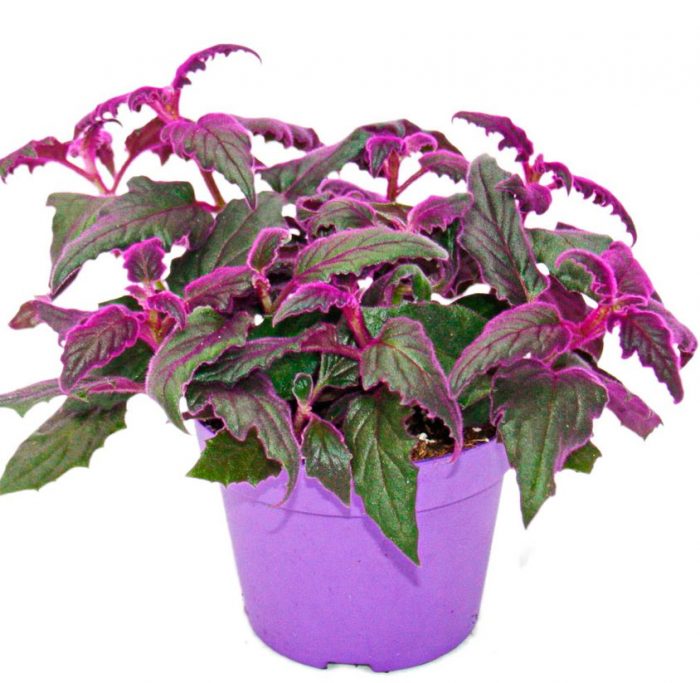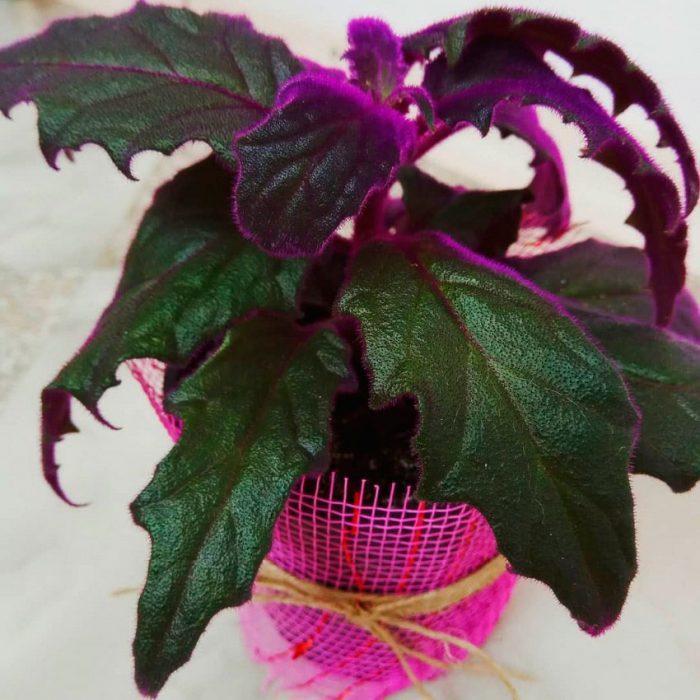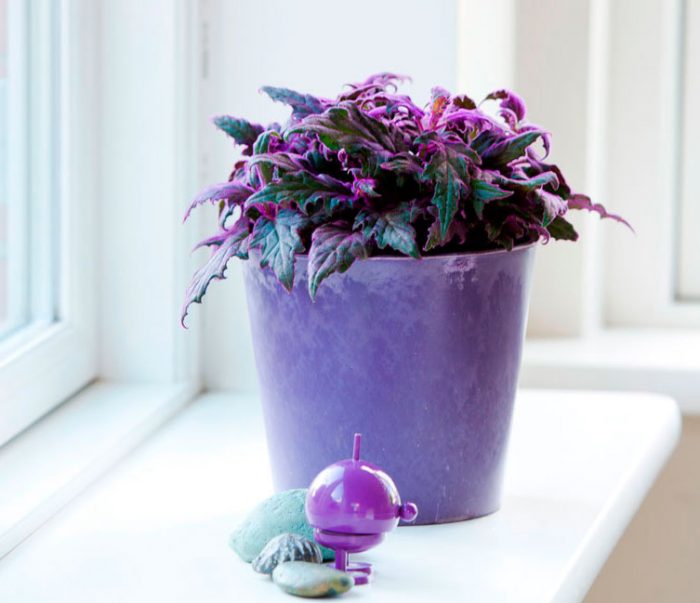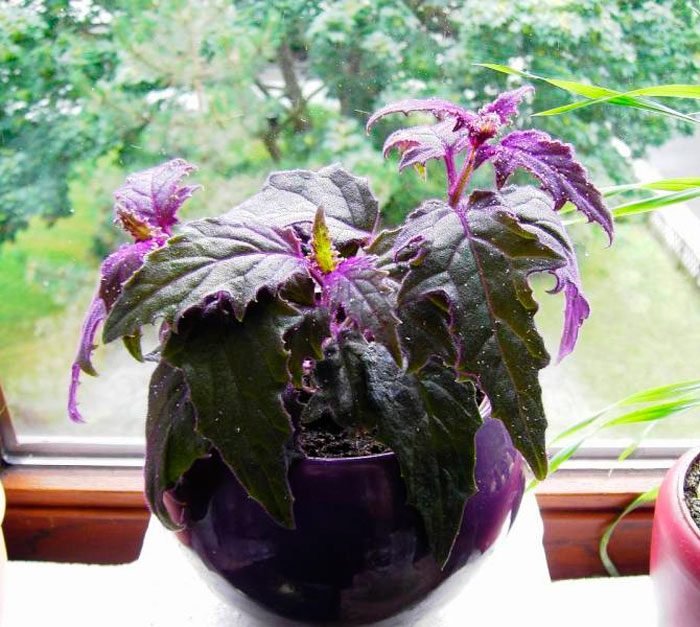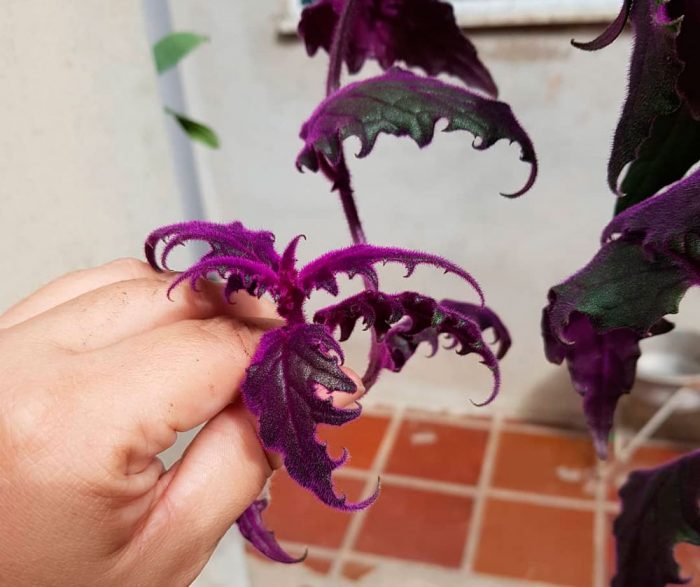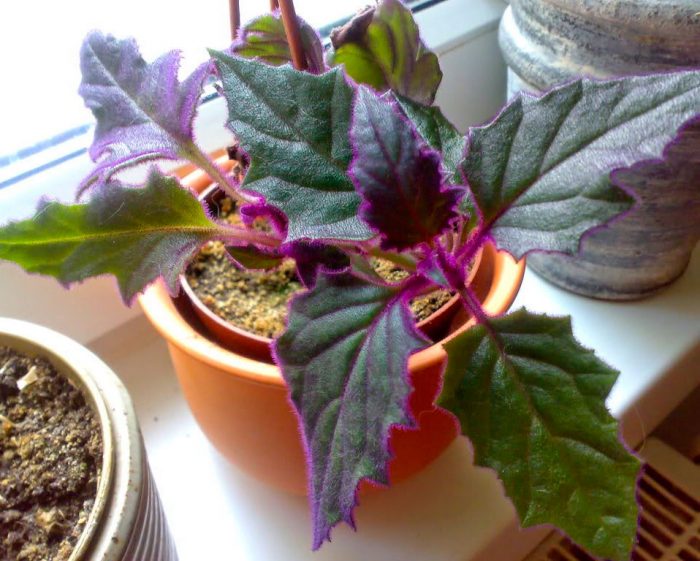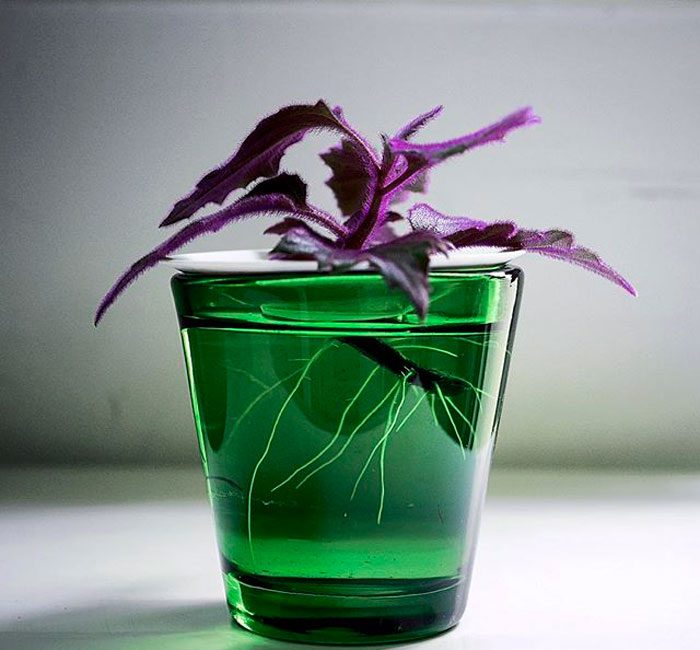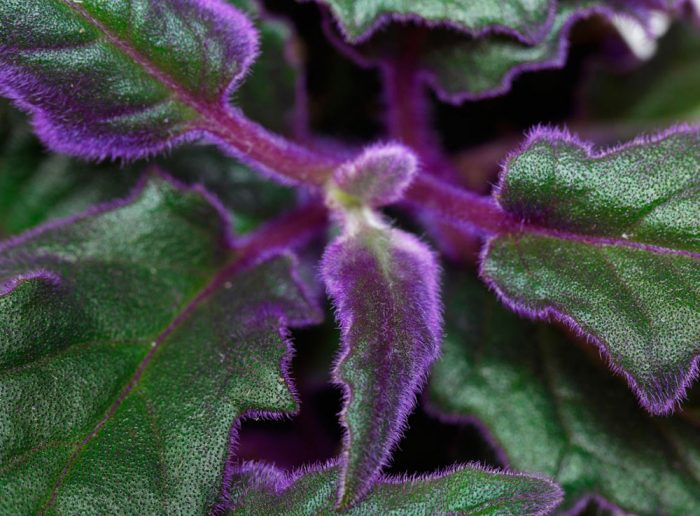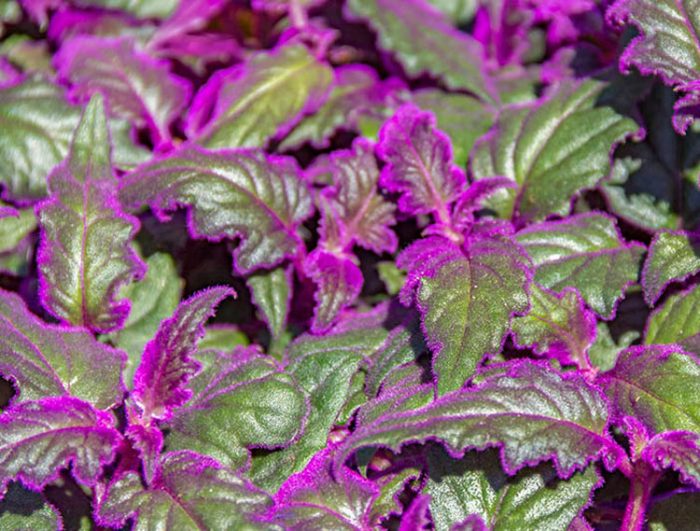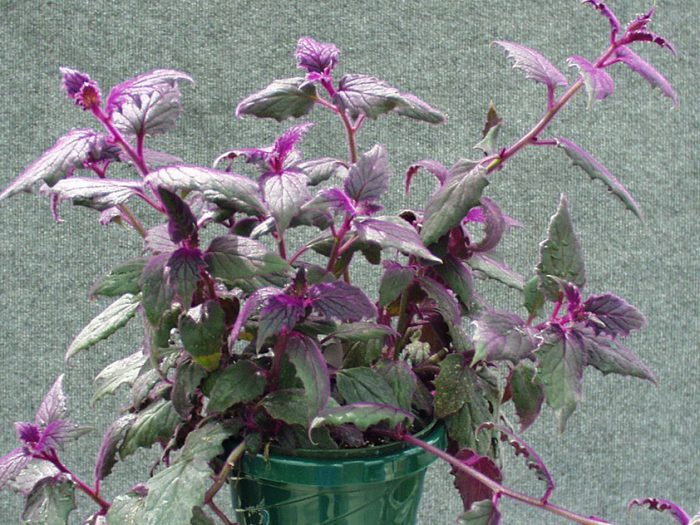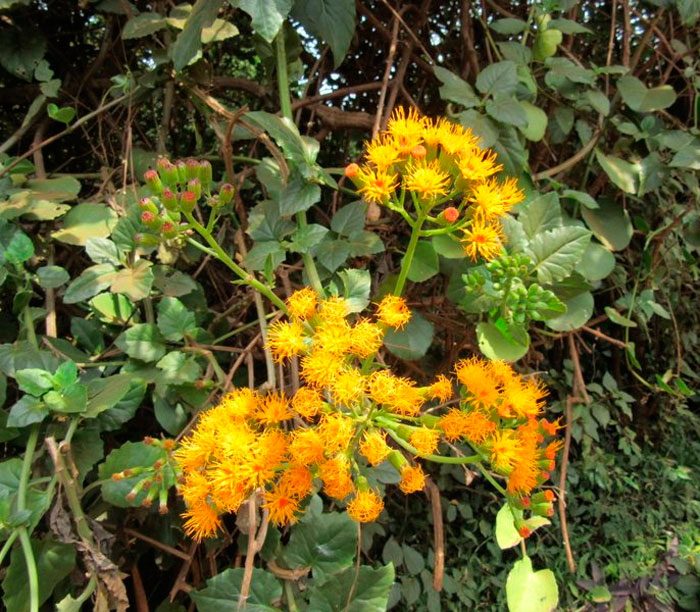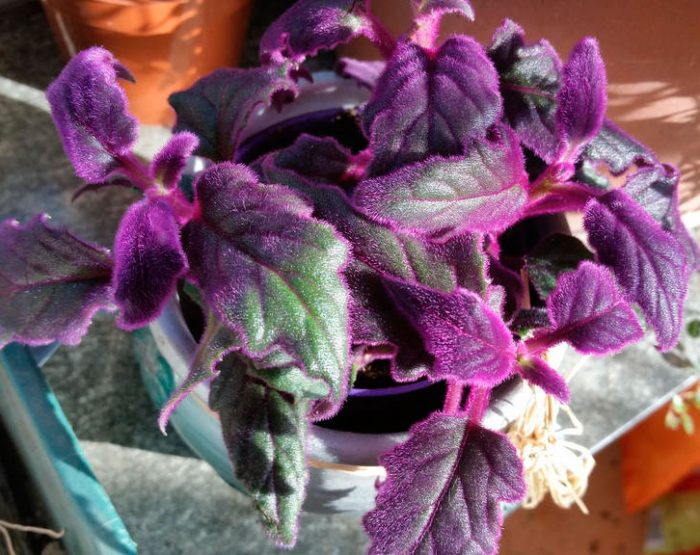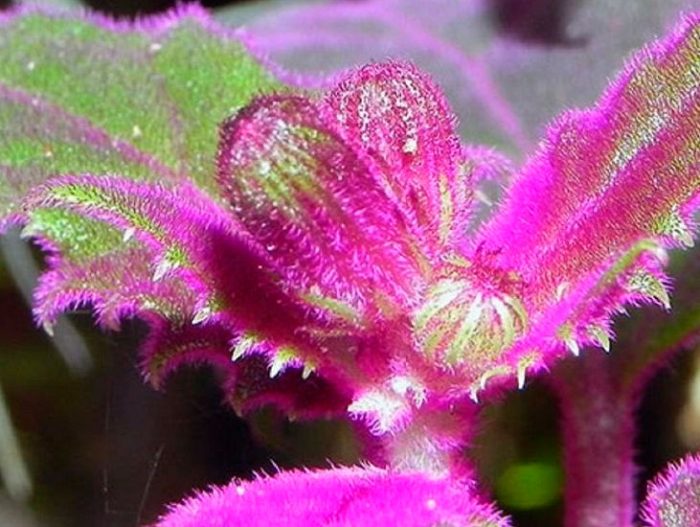The Gynura plant is part of the Asteraceae family. According to information taken from various sources, this genus unites from 47 to more than 100 species. Under natural conditions, such a plant can be found in the tropical parts of Africa and Asia. The name "ginura" is translated from Greek as "woman with a tail", most likely this is due to the long lashes of the plant. Today, at home, some of the ginura species are cultivated as an ornamental plant.
Content
Brief description of cultivation
- Bloom... Flowering begins in spring and ends in late autumn.
- Illumination... A bright light is needed, therefore it is recommended to put the bush on the south or west window, however, in the afternoon, the plant needs protection from direct sunlight. In winter, the bush needs additional lighting.
- Temperature regime... During active growth - from 18 to 24 degrees, and during rest - from 12 to 14 degrees.
- Watering... Water the plant abundantly immediately after the top layer of the soil mixture in the container dries well. If wintering is cool, then watering should be reduced.
- Air humidity... Can be anyone. However, if in winter there are working heating devices in the room where the flower stands, then wet pebbles are poured into the pallet and a pot with a flower is placed on it. It is not recommended to moisten foliage from a spray bottle.
- Fertilizer... The plant is fed during active growth once every 15 days, for this, a complex mineral fertilizer is used. During the rest period, feeding is not carried out.
- Dormant period... Winter months.
- Transfer... In the spring, only when needed. However, adult bushes need to be rejuvenated once every 2 years with a transplant.
- Reproduction... By cuttings.
- Harmful insects... Scabbards, aphids, spider mites, mealybugs and whiteflies.
- Diseases... Root rot.
Features of ginura
Ginura is an evergreen perennial shrub or herb. Creeping shoots, they reach a length of several meters. The plant has fibrous or tuberous roots, fleshy pubescent or bare shoots lignify over time.Simple alternate leaf plates can be sessile or petiolate, thin or fleshy, glabrous or pubescent, stem or collected in a socket. In some species, the seamy surface of the leaf plates is purple. The foliage can be elongated, deltoid, oblong-lanceolate, ovoid or lyre-dissected. Large or small denticles are located along the edge of the leaf plates. Flowers can be collected in terminal or axillary corymbose panicles, they are also solitary. Flowers are painted in red, orange, yellow or purple. In nature, such a plant blooms throughout the year, and the most luxuriant flowering is observed from December to the first days of summer. The flowers do not smell very pleasant, in this regard, some flower growers prefer to pick off the buds before they open.
In indoor conditions, the following species are most often cultivated: braided ginura, orange, ascending and hybrid variegated. Ginura is a fast-growing plant, and some of the species are cultivated as an ampelous plant. If you decide to grow ginura, remember that it contains poison. In this regard, when caring for this flower, be very careful and keep it away from children and pets.
Ginura care at home
Illumination
Ginura at home needs a lot of bright light, if there is little light, then the color of the foliage will become less saturated. A southern or western window is best suited for such a flower, but remember that in the afternoon for several hours the bush must be shaded from the scorching rays of the sun. Daylight hours in winter are too short for such a plant, so it requires additional mandatory lighting.
Soil mixture
Ginura will grow best in a soil mixture, which includes humus, leaf and sod soil, and sand (2: 2: 2: 1). You can also use a different substrate to grow the plant, but remember that it should be water-permeable, loose and neutral.
Temperature regime
In the warm season, the optimum temperature for growing such a flower is from 18 to 24 degrees. If in winter you do not have the opportunity to regularly highlight the ginura, then it is transferred to a cool room (no warmer than 12-14 degrees), where it can have a good rest. But if a phytolamp is installed near the bush, then it can not be transferred to a cool place.
Watering
During intensive growth, the indoor ginura must be watered abundantly. The soil mixture in the container is moistened only when its top layer dries well. If the flower hibernates in the cool, then the abundance and frequency of watering must be reduced, otherwise water will regularly stagnate in the root system, which may cause rot on it. But in the event that every day you supplement the plant with a phytolamp and the temperature in the room is above 18 degrees, then the watering regime should be like in summer. For irrigation, use well-settled (at least 24 hours) and soft water, while trying to prevent water droplets from falling on the foliage.
Air humidity
Home ginura grows normally in any humidity. However, if heating devices are actively working in the room in winter, then the air humidity will be excessively low, and in this case it is recommended to put the bush on a pallet filled with wet pebbles or expanded clay. It is highly undesirable to moisten the foliage directly from the spray bottle, as this may damage the decorative effect of the plant.
Pruning
After wintering, the ginura needs mandatory pruning so that the bush looks neat and spectacular. In addition, due to pruning, the bush will be more lush, and the growth of the stems will also accelerate.All you need to do is pinch off the tops of the shoots.
Top dressing
During intensive growth, the flower must be systematically fed, and this is done once every 2 weeks. For this, a complex mineral fertilizer is used. During the rest period, ginure is not needed.
Transfer
The transplant is carried out in the spring and only when necessary. Considering that only the leaf plates of young plants have a spectacular purple tint, it is recommended to regularly rejuvenate an adult bush, for this it is enough to transplant it once every 2 years.


Watch this video on YouTube
Reproduction
As a rule, cuttings are used to propagate ginura, because this method is very simple and quick. In the spring and summer, break off the apical stalk, which should have 2 internodes. Put it in water, and after half a month its roots will grow. It only remains to plant it in a separate pot.


Watch this video on YouTube
Ginura pests and diseases
Ginura is highly resistant to both diseases and pests. But if a bush is weakened by improper care or inappropriate conditions of detention, then the likelihood that aphids, whiteflies, scale insects, mealybugs and spider mites can settle on it.
Shields are small sucking insects that feed on plant sap. Because of this, there is a rapid yellowing of the foliage, it flies around. The development of the bush stops, it has a lag in growth. The bush gradually dries up and eventually dies. Spray the flower with Actellik's solution, after 7 days, re-treatment is carried out, but only if necessary.
Whiteflies are very small white moths that lay their eggs on the surface of foliage. To get rid of such a harmful insect, the bush is sprayed with a solution of Mospilan, Fosbecid, Aktellik, Fufanon or Confidor.
Mealybugs (furry lice) are small insects that suck the sap from the plant. And they call such insects mealy due to the fact that they leave a cotton-like waxy discharge on the shoots and foliage. The bush on which the worms live is stunted. Remember that there are types of worms that live on the roots of the plant. To exterminate this pest, you can use the following chemicals: Aktara, Mospilan, Fitoverm, Calypso and Biotlin.
Spider mites can harm any plant other than aquatic. This pest as well as scale insects and scale insects are sucking. Ticks are microscopic in size, so it is extremely difficult to see them with the naked eye. You can understand that they have settled on a bush by examining the seamy surface of the foliage, very small white dots form on it, and you can also see the thinnest cobweb there. Ticks can harm ginura very much, as they are considered one of the main carriers of viral diseases, which are currently incurable. To destroy such a pest, you can resort to the help of such means as: Agravertin, Aktellik, Kleschevit, Fitoverm, Akarin and Oberon.
Aphid is a very common pest, and it also feeds on plant sap and is considered a major vector of dangerous diseases. To destroy aphids, the bush should be sprayed several times with a solution of one of the agents that are used to combat spider mites (see above).
Types and varieties of ginura with photos and names
A relatively small number of ginura species are cultivated in indoor conditions. The species that are most popular with florists are described below.
Ginura orange (Gynura aurantiaca)
The height of such an evergreen dwarf shrub is about 100 cm.On the surface of its ribbed stems there is pubescence, they are decorated with reddish-purple petiolate unevenly serrate alternate leaf plates. The upper leaves of this species are small, and the lower ones have an ovoid shape. On the surface of the shoots and foliage there is a pile of a purple hue; therefore, in bright light, it seems that the bush is painted purple. Small flowers are collected in baskets, they have an orange or golden yellow tint. Under natural conditions, such a plant is found only on the territory of the island of Java.
Ginura wicker (Gynura sarmentosa)
Outwardly, the appearance is similar to the orange ginura, however, its shoots are drooping, so it can be cultivated as an ampelous plant. In height, the bush can reach no more than 0.6 m. The length of small leaf plates is about 70 millimeters. The homeland of such a plant is East Africa.
Climbing ginura (Gynura scandens)
Or ginura rising. This species is most often cultivated in greenhouses. It is a semi-shrub with large, sparsely toothed oval-shaped leaf blades. In length, his lashes can grow up to two meters. Such a plant looks great in an ampelous composition.
Ginura: properties and signs
Properties
In addition to poisonous species grown indoors, in nature you can still find ginura, which has healing properties. People knew about such a medicinal plant for a long time. For example, the type of ginur pinnacle is considered a very expensive and rare medicinal plant, while it is cultivated on an industrial scale only in one of the provinces of China. This type is used in medicine very widely, since it contains volatile oils, triterpene saponins, bioflavonoids, polysaccharides, amino acids and trace elements.
The common ginura, which is found naturally in America, Japan and China, also belongs to medicinal plants. It is believed that if you eat it regularly, then all diseases will bypass you. The plant energizes, improves metabolic processes, lowers blood pressure, lowers blood sugar, helps to get rid of extra pounds, and also cleanses the kidneys, blood and liver from cholesterol. If you regularly in the morning before breakfast eat two or three leafy plates of ginur, then after only half a month you will feel that the general condition of the body has improved markedly. Ginura foliage can also be used in salads.
Signs
Such a plant is also popularly called "crocodile". Since ginura flowers have an unpleasant aroma, it is under the sign of Scorpio. But experts are sure that such a flower is very useful, since it is able to cleanse the atmosphere of the home from negative energy, and ginura also helps to fight the fear of the dark and nightmares. It is also believed that the soft foliage of such a plant can soften the harsh character of a person and a harsh voice. And experts also assure that foul-smelling flowers can save amorous people from making mistakes. In this regard, they advise not to pluck the buds, but in order for the bush to better show this property, it is recommended to rearrange it in a shaded place. There is also an opinion that ginura in a home is to women's happiness ...


Watch this video on YouTube

